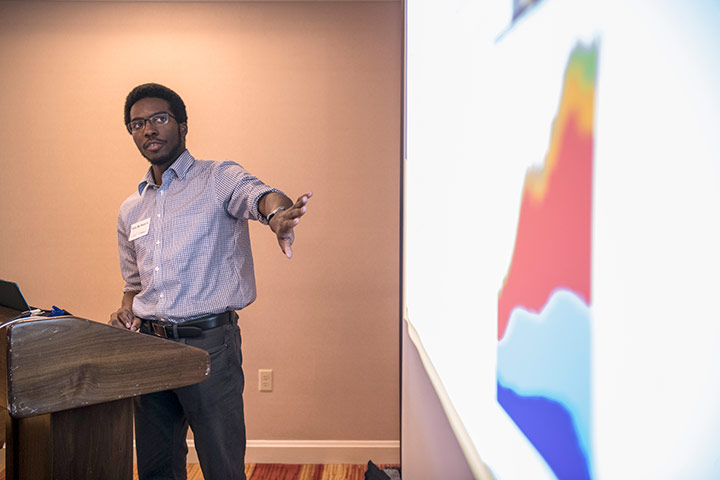2020 JUMP into STEM Winners Announced for Three Technical Challenges

This year's JUMP into STEM competition pushed students to research, collaborate, and develop possible solutions for three key issues facing the building science industry. The official 2020 challenges were advanced building construction methods, residential or commercial building energy audits, and grid-interactive efficient buildings (GEB).
"We are thrilled with this year's JUMP into STEM challenge competition submissions," said Kim Trenbath, who leads the National Renewable Energy Laboratory's (NREL's) buildings systems technology research and is NREL's JUMP into STEM manager. "Participating teams represented a variety of schools across the United States, including historically black colleges and universities. We received many high-quality submissions with innovative and thoughtful ideas. Each student team discussed how they contributed to diversity in the building sciences, whether through their backgrounds or through diversity of thought. Congratulations to the challenge winners and challenge finalists."
The winners and runners-up for each challenge are listed below.
Advanced Building Construction Methods
This challenge focused on developing innovative building materials or construction methods that increase productivity or worker safety.
Winner: Williams College—An Interdisciplinary Approach to Homeless Shelter Design
Team members Amanda Roff, Emily Kuwaye, and Jaya Alagar proposed a method to alleviate the struggles faced by homeless populations. They developed a new and sustainable concrete, a simplified architectural "module" plan for casting the concrete into single-room homes, and an integrated community design.
Runner-Up: The University of Tennessee, Knoxville—Energy Efficient Concrete Mix for Additive Manufacturing
Team members Adam Brooks, Shayan Seyfimakrani, Nathan Smith, and Daniel Zou developed a solution to improve the thermal efficiency of 3D-printed concrete. This process can reduce total and peak energy demand, total energy consumption, and cost.
Building Energy Audits for Residential or Commercial Buildings
This challenge focused on developing solutions to expedite energy audits or developing a simplified yet effective energy audit methodology. Teams needed to demonstrate the proposed solution on an existing building.
Winner: University of Georgia—Habitat for Humanity
Team members Gaspar Pedro, John (Hudson) May, and Gordon Stead developed a low-cost and simplified audit process that is economically viable for residential buildings. They tested their audit process in a Habitat for Humanity home in Athens, Georgia.
Runner-Up: Syracuse University/State University of New York College of Environmental Science and Forestry—Enabling the Proliferation of Energy Auditing
Team members Trisha Gupta, Vedyun Mishra, and Bilal Zuhric considered the impacts of COVID-19 and the need for social distancing on the future of residential auditing. They proposed the use of low- or no-touch strategies, including the use of drones and infrared cameras.
Grid-Interactive Efficient Buildings (GEB)
This challenge focused on conceptual designs that intelligently manage buildings. Students either developed algorithms that optimize active and passive building systems or developed whole-building-level low-cost automation systems that enable communications with building equipment and appliances to provide grid services.
Winner: Georgia Institute of Technology—Load Shifting with Smart Water Heaters: Conservation Without the Cold Showers
Team members Sarah Canastra, Hunter Hancock, and Lucas Kiefer proposed a strategy that shifts residential water heater energy consumption to off-peak times while still providing sufficient hot water to meet residents' needs.
Runner-Up: South Dakota State University—Utilization of Home Energy Management System (HEMS) To Mitigate the Overvoltage Problem in Photovoltaic-Rich Distribution Networks
Team members Matthew Stoel, Youjeong Jang, Saima Ishaq, and Tanveer Hussain developed optimized control strategies for a home energy management system that schedules smart energy devices (e.g., appliances, heating/cooling systems, and electric water heaters) to reduce energy bills and provide grid services.
The challenge winners, along with other finalists, will present at the JUMP into STEM Virtual Finalists Competition on Jan. 28–29, 2021.
JUMP into STEM, supported by the U.S. Department of Energy Building Technologies Office, is a collegiate competition that inspires students from diverse backgrounds to use creative ideation to solve real-world building science problems. Student teams, often made up of an interdisciplinary mix of majors, respond to one of three buildings-related challenges. JUMP into STEM strives to help close the diversity gap that exists in the building science industry by engaging students from groups that are underrepresented in science, technology, engineering, and math (STEM). JUMP into STEM encourages students from a variety of majors to solve building science problems, promoting the building science field and addressing future industry needs.
This year's challenge competition addressed some of the most pressing problems facing the building science industry. As Yeonjin Bae, subprogram manager at Oak Ridge National Laboratory (ORNL) for the Tech-to-Market Program and ORNL manager of JUMP into STEM, notes: "We received many competitive and thoughtful ideas that have clear potential for future development from various schools across the United States, and we applaud all of the teams' accomplishments. Congratulations to the challenge winners and challenge finalists."
